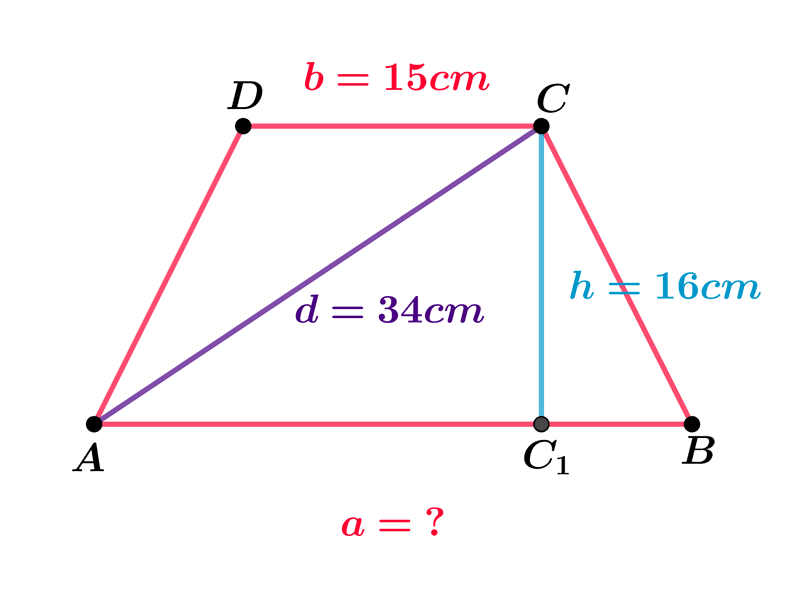
- #TRAPEZOID BASE ONE 10CM BASE TWO 5CM HEIGHT 2CM EQUALS HOW TO#
- #TRAPEZOID BASE ONE 10CM BASE TWO 5CM HEIGHT 2CM EQUALS PLUS#
#TRAPEZOID BASE ONE 10CM BASE TWO 5CM HEIGHT 2CM EQUALS HOW TO#
Why is it relevant to understand how to calculate the area and perimeter of something? This equals an area of 300 square centimetres for the kite. When you substitute the diagonal measurements, you get The kite’s area equals (p times q) divided by 2. How would you use this information to calculate the area A of a kite that is measured 20 centimetres in one diagonal p, and 30 centimetres in the other diagonal q ? Here is one way to find the area of this kite.Ī kite with interior diagonal (p) lines measuring 20 centimetres, and another diagonal (q) measuring 30 centimetres. In other words, the formula for the area of a kite is: (length × width) divided by two. Therefore, the area of the kite (the four triangles) is half the area of the entire square (the eight triangles). The area of the four triangles outside the kite is equal to the area inside the kite. You will now notice 4 interior and 4 exterior triangles. What if you used the diagonal (interior, blue) lines to form a rectangle around the kite or rhombus, as shown in the following diagram.

You could find the areas of the interior four triangle to get the area. What other shapes are within a rhombus or kite? Inside, you may notice four triangles: a pair of similar triangles on top, and a pair on the bottom. In a rhombus, the diagonal (interior, blue) lines are equal, but in a kite, the diagonal lines are not equal. The following diagram is a rhombus and a kite. (Area of Triangle 1) + (Area of Rectangle) + (Area of Triangle 2)ġ8 + 120 + 18 = 156 cm 2 A method for finding the area of a rhombus or a kite Press ‘Hint’ to reveal a perimeter hint for this shape. The base is 16 cm, height is 12 cm, and the top is 10 cm. Calculate theĪrea of a trapezoid with the following dimensions. Choose one of the methods outlined earlier in this learning activity. You can also use your notebook or the following fillable and printable document. If you would like, you can complete the next activity using TVO Mathify. For the first trapezoid, the base 1 is 15 cm, and for second trapezoid, the base 2 is 3 cm. There is an arrow beside the new shape indicating the height is 15 cm. One has been reflected vertically before being attached to the Two trapezoids have been put together to create a parallelogram. One has been reflected vertically before being attached to the other. Here is an example of what this would be.Ģ identical trapezoids.
#TRAPEZOID BASE ONE 10CM BASE TWO 5CM HEIGHT 2CM EQUALS PLUS#
In other words: (Base 1 of first trapezoid b 1 plus Base 2 of second Trapezoid b 2 ) × height of trapezoid h and divide by 2. The diagram has two identical trapezoids, with one inverted, which have been put together to create a parallelogram. In other words: (Base 1 of first trapezoid (b1) plus Base 2 of second Trapezoid (b2)) × Finally, there is the formula (b1 + b2) × h ¸ 2. Below the shape, there areĪrrows indicating Base 1 of the first trapezoid, and Base 2 of the second trapezoid. There is an arrow beside the new shape, pointing up and down, with the word “Height” in the middle. Find the area of the parallelogram and then divide it by 2.Ģ identical trapezoids. Is 3 cm, base 2 is 6 cm, and base 3 is 3 cm.Īrea = area of triangle 1 + area of rectangle + area of triangle 2.ĭouble the original trapezoid so it becomes a parallelogram.

There is an arrow beside the shape, pointing up and down, indicating that the height is 5 cm. Here is an example of how this method could be used.Ī trapezoid that has been decomposed into a triangle on left, a rectangle in centre, and a triangle on right. The formula is: area of triangle 1 (left side) + area of rectangle + area of triangle 2 (right side).Below the shape, there are arrows indicating Base 1 of the first triangle, Base 2 of the centre rectangle, and Base 3Ī trapezoid can be divided into 2 triangles and 1 rectangle. Trapezoid area method 1īreak up the original trapezoid into 2 triangles and 1 rectangle.Ī trapezoid with an arrow beside the shape, pointing up and down, with the word “Height” in the middle. Here are 2 ways to calculate the area of a trapezoid. The trapezoid can be decomposed into rectangles, parallelograms, or triangles in different ways. Using the information you already have about calculating the area of other shapes, how can you figure out the area of a typical trapezoid? There are many different ways to calculate the area of a trapezoid. What other shapes are within the trapezoid? The following shape is an example of a trapezoid. Two methods for finding the area of a trapezoid To calculate the area of triangle, we need the base and height, and not the


 0 kommentar(er)
0 kommentar(er)
